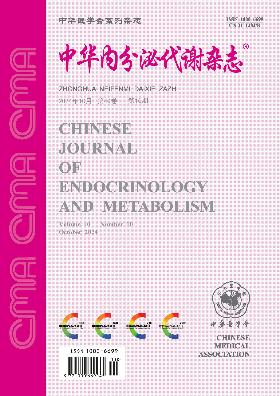新诊断2型糖尿病患者血清CTRP6水平与胰岛素抵抗的关系
Q4 Medicine
引用次数: 0
摘要
目的探讨新诊断2型糖尿病(T2DM)患者血清C1q、肿瘤坏死因子相关蛋白6(CTRP6)水平与胰岛素抵抗的关系。方法选取2016年4月至2017年3月在我院门诊就诊的新诊断T2DM患者167例,以糖耐量正常的165例为对照组。ELISA法检测各组小鼠CTRP6、白细胞介素6 (IL-6)、单核细胞趋化蛋白-1 (MCP-1)、肿瘤坏死因子α (TNF-α)的浓度。结果调整年龄和体重指数(BMI)后,T2DM组循环CTRP6水平明显高于对照组[(652.54±132.57)vs(521.28±119.93)μg/L, P<0.01]。超重/肥胖受试者的CTRP6水平高于瘦人。此外,循环CTRP6水平与BMI、腰围、空腹血糖、餐后2h血糖、HbA1C、空腹胰岛素、稳态模型评估胰岛素抵抗指数(HOMA-IR)、甘油三酯(TG)、IL-6、MCP-1、高敏感c反应蛋白(hs-CRP)、TNF-α呈正相关,与高密度脂蛋白-胆固醇呈负相关(P<0.01)。多元线性回归分析显示TG、HOMA-IR、IL-6是影响CTRP6水平的独立因素。在调整了潜在的混杂因素后,CTRP6仍然是T2DM的独立危险因素。趋势检验显示CTRP6水平的升高与T2DM的发生呈显著的线性关系。受试者工作特征曲线分析显示,循环CTRP6预测T2DM的曲线下面积为0.730。结论CTRP6可能与胰岛素抵抗有关。关键词:C1q/ tnf相关蛋白-6;2型糖尿病;炎症;胰岛素抵抗本文章由计算机程序翻译,如有差异,请以英文原文为准。
Relationship between serum CTRP6 level and insulin resistance in patients with newly diagnosed type 2 diabetes mellitus
Objective
To explore the relationship between serum C1q and tumor necrosis factor related protein 6(CTRP6) level and insulin resistance in patients with newly diagnosed type 2 diabetes mellitus (T2DM).
Methods
A total of 167 patients with newly diagnosed T2DM in the outpatient department of our hospital were recruited from April 2016 to March 2017 and 165 subjects with normal glucose tolerance were used as the control group. The concentrations of CTRP6, interleukin 6 (IL-6), monocyte chemoattractant protein-1 (MCP-1), and tumor necrosis factor α (TNF-α) were determined by ELISA.
Results
Circulating CTRP6 level was significantly higher in T2DM group than that in control group [(652.54±132.57) vs (521.28±119.93)μg/L, P<0.01] after adjusting age and body mass index (BMI). Overweight/obese subjects revealed higher CTRP6 levels compared with those in lean individuals. In addition, circulating CTRP6 level was positively correlated with BMI, waist circumference, fasting plasma glucose, postprandial 2h plasma glucose, HbA1C, fasting insulin, homeostasis model assessment insulin resistance index (HOMA-IR), triglyceride (TG), IL-6, MCP-1, highly sensitive C-reactive protein (hs-CRP), and TNF-α, while it was inversely correlated with high-density lipoprotein-cholesterol(P<0.01). Multivariate linear regression analysis showed that TG, HOMA-IR, and IL-6 were independent factors for CTRP6 level. After adjusting for potential confounders, CTRP6 remained an independent risk factor for T2DM. Trend test showed that the increase in CTRP6 level was significantly linear with the occurrence of T2DM. The analysis of receiver operating characteristic curves revealed that the area under the curve for circulating CTRP6 to predict T2DM was 0.730.
Conclusions
CTRP6 may be associated with insulin resistance.
Key words:
C1q/TNF-related protein-6; Diabetes mellitus, type 2; Inflammation; Insulin resistance
求助全文
通过发布文献求助,成功后即可免费获取论文全文。
去求助
来源期刊

中华内分泌代谢杂志
Medicine-Endocrinology, Diabetes and Metabolism
CiteScore
0.60
自引率
0.00%
发文量
7243
期刊介绍:
The Chinese Journal of Endocrinology and Metabolism was founded in July 1985. It is a senior academic journal in the field of endocrinology and metabolism sponsored by the Chinese Medical Association. The journal aims to be the "Chinese broadcaster of new knowledge on endocrinology and metabolism worldwide". It reports leading scientific research results and clinical diagnosis and treatment experience in endocrinology and metabolism and related fields, as well as basic theoretical research that has a guiding role in endocrinology and metabolism clinics and is closely integrated with clinics. The journal is a core journal of Chinese science and technology (a statistical source journal of Chinese science and technology papers), and is included in Chinese and foreign statistical source journal databases such as the Chinese Science and Technology Papers and Citation Database, Chemical Abstracts, and Scopus.
 求助内容:
求助内容: 应助结果提醒方式:
应助结果提醒方式:


